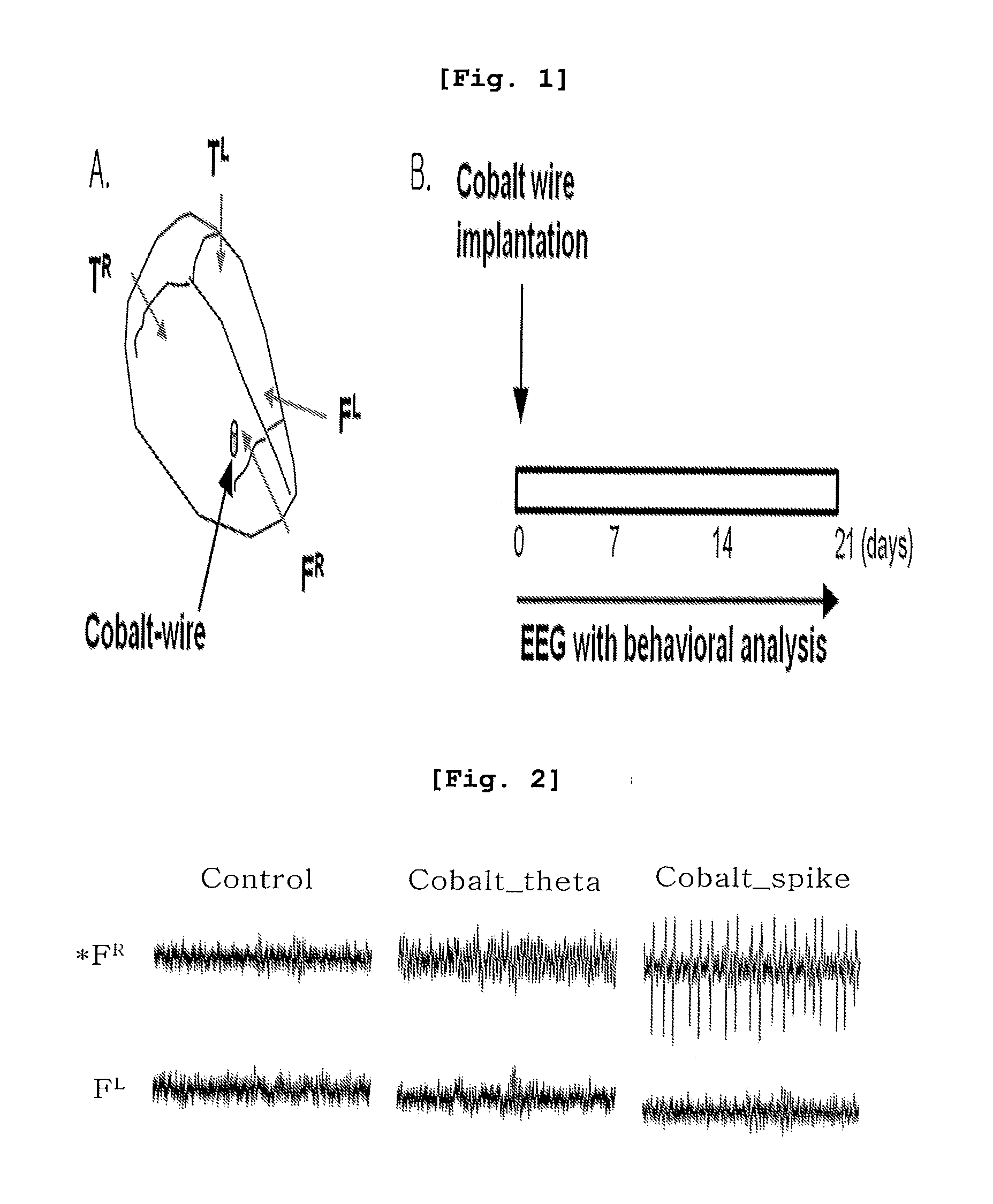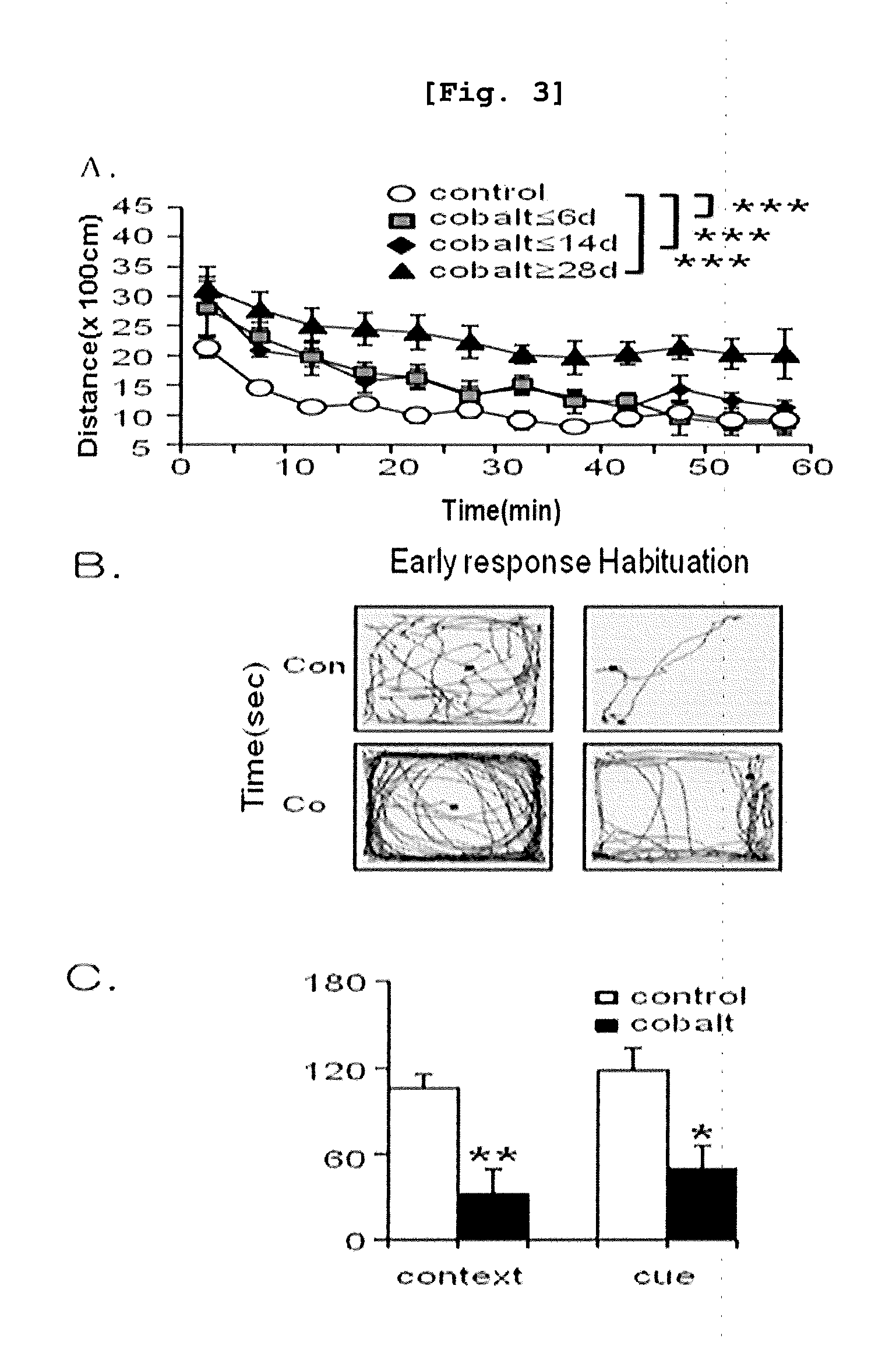Model Mouse of Attention Deficit Hyperactivity Disorder, Method for Investigating Effects for Preventing and Alleviating Attention Disorder using the Model Mouse, and Method for Treating Attention Disorder by Suppressing T-Type Calcium Channel
- Summary
- Abstract
- Description
- Claims
- Application Information
AI Technical Summary
Benefits of technology
Problems solved by technology
Method used
Image
Examples
example 1
Construction of ADHD Animal Model
[0184]C57BL / 6J mice at 10˜20 weeks (BioModel System Park) were raised and treated according to standard animal care protocols of Korea Advanced Institute of Science and Technology (KAIST). Water and feed were provided freely and light / dark cycle was 12 hours.
[0185]Cobalt wire known to cause hypoxia was inserted in the right frontal lobe of the mouse to construct the ADHD animal model.
[0186]Particularly, to construct the ADHD mouse model, 0.2% avertin in 20 mg / ml of tribromoethanol was administered to the mouse by intraperitoneal injection (i.p.) to anesthetize it. The head of the mouse (B6 mouse at 10˜20 weeks) was fixed on stereotaxic (David Kopf Instruments, Germany) and then cobalt wire (Alfa Aesar) was inserted therein by using holder, a part of stereotaxic. Cobalt wire (Alfa Aesar) of 500 μm in the diameter was inserted radially (vertical direction to the cortical surface) in the location of anteroposteriorally 2.6 mm, laterally 1.8 mm, and vent...
example 2
Construction of T-Type Calcium Channel Knockout Animal Model
Construction of Cav3.1 T-Type Calcium Channel Knockout Animal Model
[0190]Cav3.1 T-type calcium channel knockout mouse model (Knockout, KO, − / −) was constructed by mating hetero mice having α1G T-type calcium channel only in the chromosome of one side (Neuron, 2001, Lack of the Burst Firing of Thalamocortical Relay Neurons and Resistance to Absence Seizures in Mice Lacking [alpha] 1G T-Type Ca2+ Channels). The knockout mouse prepared by such mating had no α1G T-type calcium channel at all in the whole body.
Construction of Animal Model in which α1G T-Type Calcium Channel was Partially Removed in the Mediodorsal Thalamus
[0191]Lentivirus vector expressing shRNA targeting Cav3.1 T-type calcium channel was constructed. The synthesized double oligonucleotide (SEQ. ID. NO: 1; 5′-CGGAATTCCGGGAAGATCGTAGATA GCAAAttcaagagaTTTGCTATCTACGATCTTCTTTTTGATATCTAGACA-3′) was inserted in shLentisyn3.4G lentivirus vector (Macrogen, KOREA). The ...
experimental example 1
Observation of Brain Wave of ADHD Animal Model
[0196]To investigate whether or not the animal model constructed by inserting cobalt wire in the right frontal lobe in Example 1 could be used as the ADHD animal model, the inventors observed ADHD-specific brain wave.
[0197]For the measurement of brain wave (electroencephalogram, EEG) of the said animal model, EEG electrode was inserted in the right and left frontal lobes and the right and left temporal lobes, followed by observation of brain wave for 30 days. EEG electrode was inserted at the same time with cobalt wire. Like cobalt wire insertion, EEG electrode was inserted by using stereotaxic in the coordinate calculated.
[0198]Particularly, cobalt wire (Alfa Aesar) of 500 μm in diameter was inserted radially (vertical direction to the cortical surface) in the location of anteroposteriorally 2.6 mm, laterally 1.8 mm, and ventrally 1.3 mm in the right dorsolateral frontal lobe. For the record of EEG, epidural electrode was inserted in th...
PUM
| Property | Measurement | Unit |
|---|---|---|
| Length | aaaaa | aaaaa |
| Length | aaaaa | aaaaa |
| Length | aaaaa | aaaaa |
Abstract
Description
Claims
Application Information
 Login to View More
Login to View More - R&D
- Intellectual Property
- Life Sciences
- Materials
- Tech Scout
- Unparalleled Data Quality
- Higher Quality Content
- 60% Fewer Hallucinations
Browse by: Latest US Patents, China's latest patents, Technical Efficacy Thesaurus, Application Domain, Technology Topic, Popular Technical Reports.
© 2025 PatSnap. All rights reserved.Legal|Privacy policy|Modern Slavery Act Transparency Statement|Sitemap|About US| Contact US: help@patsnap.com



